
ASSEMBLY INSTRUCTIONS/OPERATION
cutting edge faces down against the surface. FIGURE
4.This configuration allows the blade to skim over the surface and minimize any tendency to gouge or dig into the wood. A slotted blade configuration is employed to lower installation and removal time. The slotted configuration is also intended to help minimize direct exposure of hands, arms and other body parts to the blade during the installation or removal process.
FIGURE 3
FIGURE 4
![]() CAUTION
CAUTION
Aprotective covering is provided to protect the blade cutting edge from external damage and minimize the potential for property damage and/or personal injury.
Store the blade with the protective covering properly installed to minimize the effects of external damage to the cutting edge and the potential for property damage and/or personal injury.
![]() DANGER
DANGER
THE BLADE IS EXTREMELY SHARP. IMPROPER HANDLING WHILE REMOVING FROM THE PACKAGE, REMOVING/REINSTALLING THE
PROTECTIVE CUTTING EDGE COVER, INSTALLING/REMOVING FROM THE MACHINE OR WHILE IMPROPERLY TRANSPORTING CAN RESULT IN PROPERTY DAMAGE AND/OR PERSONAL INJURY.
While individual blade or accessory attachment design and configuration may vary, basic operational characteristics are identical: impact against a floor surface and remove the covering material. This common operational characteristic has led to the development of the following popular blade configurations and accessory attachments:
Angled Mastic Removal Blade.
This blade configuration is utilized to remove a wide variety of adhesives, mastics and material residues from concrete surfaces. The steep angle increases the cutting edge position relative to the floor surface. The angle increase allows the blade to better penetrate the material and then shear and scrape it from the floor surface. The cutting edge faces down toward the floor surface. Angled mastic blades are utilized on concrete surfaces only. Use on wood surfaces will only dig into and remove substrate material. FIGURE 5.
FIGURE 5
Straight Beveled Cutting Edge Blade.
This blade configuration is utilized to remove a wide variety of VCT and linoleum tiles along with general material removal from concrete and wood surfaces. Some blades feature two cutting edges. Position the blade edge facing up for use on concrete surfaces.
| OPERATION AND PARTS MANUAL REV #4 (05/28/09) | PAGE 13 |
|
|
|
